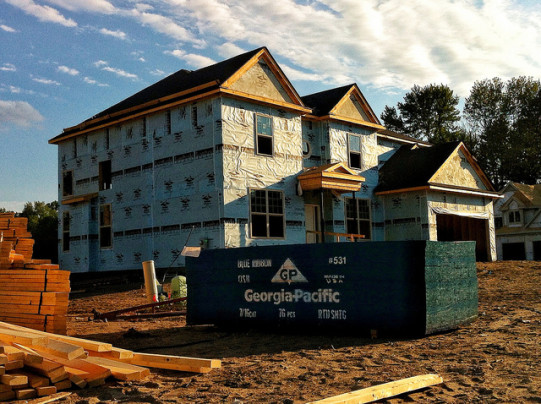According to the Mortgage Bankers Association’s Weekly Applications Survey, average mortgage rates on 30-year fixed-rate mortgages with conforming loan balances rose slightly last week. In fact, average rates increased across most loan categories, including loans backed by the Federal Housing Administration and 15-year fixed-rate mortgages. Only 30-year loans with jumbo balances saw declines from the week before. Increasing rates caused a drop in refinance activity, which fell 4 percent from the previous week. On the other hand, the seasonally adjusted measure of demand for loans to purchase homes remained unchanged from one week earlier and is now 21 percent higher than it was at the same time last year. Because demand for purchase applications is a good indicator of future home sales, the year-over-year improvement is an encouraging sign that the spring selling season is off to a strong start and this year’s sales pace should be better than last year’s. Mortgage rates, though up from a week ago, remain well below historical norms and are among the reasons many analysts are optimistic about residential real estate this year. The MBA’s weekly survey covers 75 percent of all retail residential mortgage applications and has been conducted since 1990. More here.
Archive for April 2015
Americans Say Real Estate Is The Best Investment
A recent survey of Americans found that more respondents named real estate as the best long-term investment over stocks, gold, savings accounts/CDs, or bonds for the second-straight year. The results, recently released by Gallup, showed 31 percent of Americans chose real estate, followed by 25 percent of participants who said stocks/mutual funds. This wasn’t the case as recently as a couple of years ago, however. In fact, both real estate and the stock market suffered a significant slump in public perception following the housing crash and financial crisis. Since then, a stabilizing housing market and rebounded stock market have led to increasing confidence. Now, real estate is either the top choice or tied for first among all gender, age, and income groups. Gold, on the other hand, has been on a downward trajectory in recent years. The most popular choice in 2011 and 2012, gold came in third this year, falling five percentage points in just the past 12 months. More here.
60% Of Metro Markets Show Improving Trend
The housing market’s recovery has been a gradual one, with many ups-and-downs along the way. Of late, the news has been optimistic and generally positive with many analysts forecasting stronger gains ahead. But despite the rosy outlook, there is still a lot of room for improvement. In fact, according to Freddie Mac’s Multi-Indicator Market Index – which measures the stability of the housing market based on several indicators such as home purchase applications, payment-to-income ratios, and proportion of on-time mortgage payments – the national housing market has only made a 31 percent rebound since its all-time low in October 2010. However, over the last year, it has improved an additional 3.53 percent and, according to the most recent data, 60 percent of the top 100 metro areas are showing an improving three-month trend. Len Kiefer, Freddie Mac’s deputy chief economist, says the improvement is good news. “Of the top 100 metro areas, over 60 are showing purchase applications up from the same time last year with over 20 of those metro areas showing double-digit percentage increases,” Kiefer said. “Likewise, the employment picture continues to improve in most markets helping to support greater interest in purchasing a home.” Among the states showing the most improvement, Oregon, Michigan, Florida, California, and Kentucky topped the list. More here.
New Home Sales Up 20% From Last Year
In March, sales of newly built, single-family homes slowed from the month before, falling 11.4 percent, according to new estimates released by the U.S. Census Bureau and the Department of Housing and Urban Development. However, new home sales are now nearly 20 percent higher than they were last year at this time and are coming off their best month in seven years. In other words, the spring sales season is off to a good start despite the monthly decline. And the year-over-year improvement in new home sales is just one of many indicators trending upward. For example, sales of previously owned homes recently registered their largest one-month increase in five years while, at the same time, surveyed home builders are expressing growing optimism about the health of the market. Also, a closer look at the numbers reveals large regional differences in the number of new homes sold during the month. In fact, the Northeast posted a 33.3 percent drop in sales while the Midwest actually saw a sales increase of nearly 6 percent. Sales in the South and West were also down but not as significantly as they were in the Northeast. Also in the report, the median sales price of new homes sold in March was $277,400; the average sales price was $343,300. More here.
Home Sales Start Spring With A Surge
New numbers from the National Association of Realtors show sales of previously owned homes up 6.1 percent in March from the month before. The increase was the largest one month improvement since 2010 and brought sales to their highest annual rate since September 2013. Lawrence Yun, NAR’s chief economist, said the housing market appears to be off to an encouraging start this spring. “After a quiet start to the year, sales activity picked up greatly throughout the country,” Yun said. “The combination of low interest rates and the ongoing stability in the job market is improving buyer confidence and finally releasing some of the sizable pent-up demand that accumulated in recent years.” In fact, that same pent-up demand has been responsible for six straight months of year-over-year improvement, which has pushed existing home sales 10.4 percent above last year’s level. Regionally, sales were strongest in the Midwest, where they rose 10.1 percent above the previous month. Each region of the country saw increases, however, with the Northeast and West both gaining more than 6 percent. Also, the median existing-home price for all housing types was $212,100 in March. More here.
Demand For Loans To Buy Homes Rises Again
According to the Mortgage Bankers Association’s Weekly Applications Survey, the number of prospective home buyers requesting applications for loans to buy homes has risen four of the past five weeks. Last week, the seasonally adjusted purchase index was up 5 percent from the week before and 16 percent above last year’s level. Because the purchase index is a good indicator of future home sales, the gains are a good sign for the spring housing market. After a slow first quarter, many analysts have forecasted a strong spring for home sales and an increase in purchase application demand could be an early sign that they’re right. Also in the report, average mortgage rates fell across all loan categories, including 30-year fixed-rate mortgages with both conforming and jumbo balances, loans backed by the Federal Housing Administration, and 15-year fixed-rate mortgages. Despite favorable rates, however, refinance activity was only up 1 percent from the previous week. The MBA’s weekly survey covers 75 percent of all retail residential mortgage applications and has been conducted since 1990. More here.
When Will Return Buyers Come Back To The Market?
Between 2006 and 2014, nearly 9.3 million borrowers were foreclosed on, received a deed in lieu of foreclosure, or short sold their home. If, when, and how these former homeowners return to the housing market will likely have a significant impact on residential real estate in the years ahead. For this reason, these potential buyers are the subject of a recent analysis from the National Association of Realtors. According to their data, nearly a million of these buyers have already returned and an additional 1.5 million are likely to buy a house in the next five years. Still, there are more than 500,000 former homeowners that are either hampered by tight lending standards or only qualified for a mortgage in the first place because of the loose lending standards of the mid-2000s. Still, with an economy and job market on the mend, in addition to rebounding home prices and wage growth, there will be an ever larger group of former homeowners who will have, not only the desire to buy a house, but the means. Along with pent-up demand among younger Americans hoping to become first-time buyers and current homeowners looking to trade-up from their current residence, these potential home buyers will have an impact on home sales and the housing market at large over the next decade. More here.







